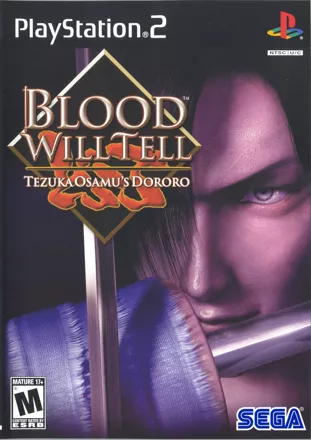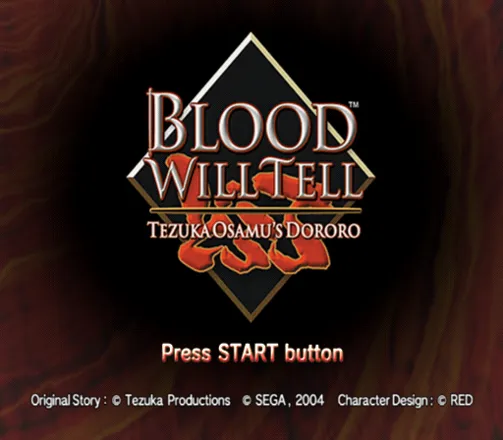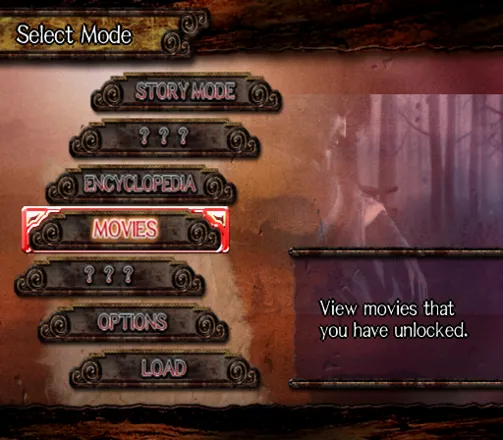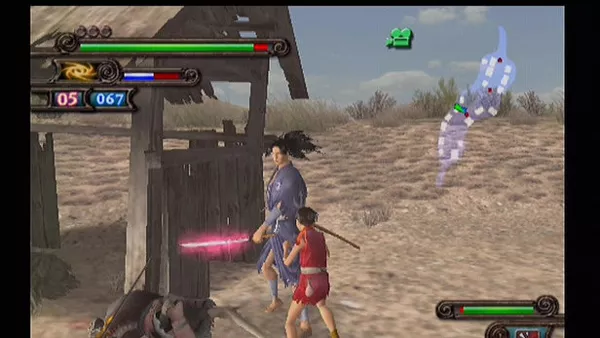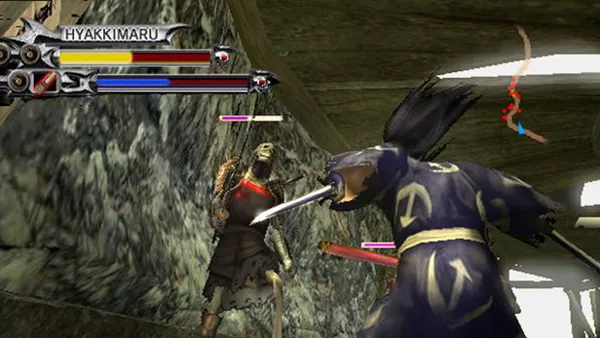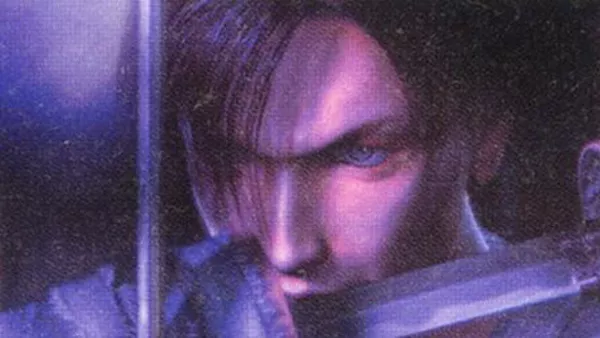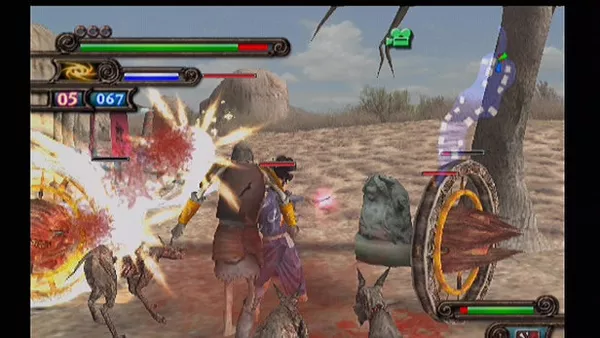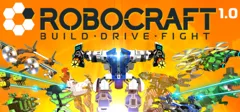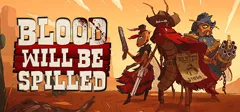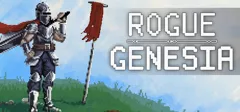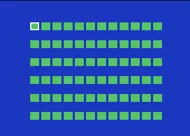Blood Will Tell: Tezuka Osamu's Dororo
Description official descriptions
Seduced by the power offered to him, a samurai allows harm to come to his infant son. The son, fated to destroy the 48 Fiends, has 48 body parts removed, one by each demon. The samurai sets the remains adrift along a river, where the still-living child is discovered by a kindly doctor. After raising the child, the doctor operates on him, replacing his missing parts with mechanical ones. Knowing the child's destiny, the doctor replaces his missing arms with sword arms, attaches a repeating rifle to one arm, and a cannon to one leg. The game begins with the now-adult Hyakkimaru beginning his quest to reclaim his body parts from the Fiends. Soon joined by the child-thief Dororo, the pair embark on a quest against ancient Japanese demons and the monsters they create.
Blood Will Tell is an action game where the player controls Hyakkimaru, a man whose body parts were stolen by demons when he was a child. His destiny is to reclaim each of his body parts, which allow him to increase his stats such as HP and power, as well as optional special functions (for example, the eye displays the game in colour, while the vocal chords allow him to speak). Hyakkimaru wields a sword, which can be used to attack enemies - he can also swap for his two smaller swords concealed within his arms. As he uses the swords, they level up and increase in power. Hyakkimaru can also charge up a sword attack, and if released at the correct time, is given the opportunity to enter a series of button presses for combos. If the enemy is killed during this combo, the player can perform a finishing move with the Triangle button which can yield bonus items ranging from health items to swords.
Hyakkimaru is also outfitted with a repeating rifle and a cannon in his leg. While these are very powerful, they both require their own ammo and cannot be used without it. The gun can be fired rapidly at foes, while the cannon must be charged and aimed for a powerful shot. Both of these weapons have the advantage of being long-range weapons, unlike his swords which must be used at close quarters.
At a certain point in the game, Hyakkimaru meets the child thief, Dororo. Dororo often assists Hyakkimaru during combat, and can be issued commands, such as 'fight', 'evade', 'collect items' or 'search'. Sometimes the pair will split up, and Dororo will be playable on his own. These sections are more puzzle-based, with the thief pulling switches to activate puzzles, dodging traps, and stealing items. Dororo can throw rocks from a distance, and later gets smoke bombs which are more incapacitating.
Spellings
- 多罗罗 - Chinese spelling (simplified)
Groups +
Screenshots
Promos
Credits (PlayStation 2 version)
135 People · View all
| Hyakkimary | |
| Dororo | |
| Kagemitsu Daigo | |
| Tahoumaru | |
| Saburota | |
| Mio | |
| Tanosuke / Dragon Brood / Nine-Tailed Fox | |
| Misaki | |
| Troll / Legion | |
| Yudai | |
| Redcap | |
| Legion | |
| Maimai´Onba | |
| Narrator / Jyukai | |
| Original Story | |
| Character Design | |
| Creature Design / Storyboards (Opening Movie) | |
| Production Design | |
| Supervision |
|
| Producer (Red Entertainment) | |
| Story and Design (Red Entertainment) | |
| Support (Red Entertainment) | |
| Executive Producer |
|
| Motion Capture |
|
| [ full credits ] | |
Reviews
Critics
Average score: 71% (based on 23 ratings)
Players
Average score: 4.0 out of 5 (based on 6 ratings with 1 reviews)
Medieval Japanese Cyborg takes on Netherworld
The Good
When a noble samurai is tricked by the 48 Fiends into trading what he cherishes most for the power to unify the country, his son is savaged by the Fiends—each one ripping away a different body part. Setting his son’s remains adrift, the samurai abandons the child. Luckily a doctor finds the boy, Hyakkimaru, and nurses him back to health.
Using medicine and technology, the doctor repairs the boy, crafting replacement parts and turning him into the medieval Japanese equivalent of a cyborg. Detachable arms hide sword blades and a machinegun; one of his makeshift legs disguises a cannon; artificial eyes provide rudimentary sight, presenting the world in monochrome. Hyakkimaru is prepared for battle, but not, the doctor charges him, against humans. Instead Hyakkimaru will wage war against the 48 Fiends and the demons they’ve unleashed on the land. For each Fiend Hyakkimaru defeats, he will regain a body part and his quest will not end until he is made whole again.
Very early on, Hyakkimaru finds and teams up with Dororo, a child-thief and the main character of the late 1960s manga and anime series (until Hyakkimaru overshadowed him… her… there as well). Dororo is definitely a girl, but is largely presented as a gender neutral character. She envisions herself as a great thief and while Hyakkimaru dominates the action portions of the game, Dororo gets the typical platform elements. Each of the game’s six chapters have Dororo-only sections, where Dororo gets to perform difficult jumps, hurl rocks and other projectiles at demons (and the occasional Fiend), and explore areas Hyakkimaru can’t due to either his larger size or the story’s constraints.
Most of the game sees Dororo in a supporting role to the player-controlled Hyakkimaru. Hyakkimaru can issues general default orders to Dororo, such as telling her to throw rocks at the enemies, pick up various power-ups for Hyakkimaru, or explore the area for secrets. There is also an option to have a second player control Dororo, but since the camera stays focused on Hyakkimaru, it doesn’t amount to much in terms of gameplay. Also of note, Dororo cannot die except in Dororo-only levels, so the player doesn’t have to worry about her much. While Dororo does her thing, Hyakkimaru is doing what he does best—insane amounts of combat.
From the beginning, Hyakkimaru has two sword arms, the machinegun, the cannon, and a standard sword. The more Hyakkimaru uses his sword arms, the stronger they become. The machinegun and the cannon have limited ammo, but prove very useful in boss battles. Random swords do very little, but it doesn’t take long for Hyakkimaru to find swords that have unique abilities. Fire swords do fire damage and also reduce the damage Hyakkimaru takes from fire effects, other swords have similar abilities and each sword has its own level (which, unlike the sword arms, does not increase). The levels come into play during boss battles. Each boss has its own level and, in most cases, Hyakkimaru will want to use a weapon of equal level.
Hyakkimaru also has other tricks up his sleeve to use against the game’s 100 types of demons and 48 Fiends. In addition to executing powerful combination attacks, he can find scrolls containing spirit attacks and unleash devastating bolts of lightning, whirlwinds of sword slashes, and other special attacks when his spirit meter is full. Hyakkimaru can also enter into a frenzy mode and follow onscreen button patterns to whittle away a demon’s health.
Typically, levels are somewhat linear, with Hyakkimaru and Dororo following a path and fighting the demons that pop up along the way. Different battle modes break up what would be a monotonous exercise, such as annihilation battles where Hyakkimaru must kill a set number of demons to continue, non-lethal combat where Hyakkimaru must defeat his opponents with the flat of his blade and with Dororo’s assistance or any special attacks, and boss battles.
Throughout the game’s six levels (there’s an unlockable seventh bonus level, too), Hyakkimaru fights some Fiends as part of the storyline and finds others by exploring secret areas. It’s impossible to find every Fiend on a level’s first play-through, but you can revisit completed levels to hunt them down. Defeating a Fiend means Hyakkimaru regains a body part, and though this may seem like a downgrade, it actually makes him stronger, faster, and healthier. Gaining an eye gives Hyakkimaru color vision (the game starts in monochrome), other body parts cause the controller to shake when Fiends are near, or lets Hyakkimaru regain his balance after being knocked off his feet.
With misty forests, windswept desert expanses, ghost towns, and skeleton-strewn battlefields, this game gets high points for graphics and variety. Enemies, though numerous, are detailed and mostly distinctive, although the later Fiends occasionally look like scarier versions of earlier Fiends. Did I say scary? The demons and Fiends have some of the most frightening visages I’ve seen even though the game doesn’t attempt to scare the player. These monsters have been ripped straight from Japanese mythology and one of them is big enough to give Godzilla a run for his money.
The Bad
There’s a great game in here held back by some serious flaws. First up is the M-rating. This is a bloody game, but it’s never gory. And since Hyakkimaru only uses deadly force against demons and Fiends, you can’t even call it blood. And how is a giant stone monster bleeding anyway? That’s just dumb. Giving this game an M-rating puts it in the same league as Onimusha and other games that it’s really nothing like. With Dororo as an important (and obviously kid-friendly) character, Blood Will Tell has a weird schism between what it is and how it perceives itself.
So you have this M-rated game, which includes a good amount of making a prepubescent girl complete a series of jumping puzzles while she’s collecting enough green dots to get a 1-up, and you start to wonder what you’re doing. I mean, there’s nothing wrong with Dororo, other than the fact that her levels are a little jarring, but imagine if portions of The Lord of the Rings had sections similar to The Hobbit.
Of course this is all made worse since the camera system is more interested in cinematics than showing what’s in front of you. I love interesting camera angles, but not if it’s keeping me from jumping on a platform, or hiding enemies from my view, or hiding me from my view just so we can get a good look at a Fiend.
And then there’s the save/load system. Okay, you save the game and then call it quits. When you restart the game, you select which save game you want to reload and after it loads it takes you to a menu. Then you select the Story option and once again tell the game to load. Then you’re back in the game. A little streamlining would help. More annoying is simply reloading after you die. Please ask us, when we die, if we want to restart rather than loading a menu screen and making us reload from there.
Final annoyance. Cutscenes use the game’s engine. So if a cutscene takes place in three separate areas, you get three load screens. Well planned!
The Bottom Line
I don’t love Blood Will Tell, but I do think it’s a pretty good game. The strength of the storyline alone covers many of the flaws. Personally, I was captivated during a scene where Hyakkimaru and Dororo slept along opposite sides of a river bank and troll emerged from the mists, ringing a bell and croaking, “Want some?” Hyakkimaru whispers something to the troll that Dororo can’t hear. Eerie, atmospheric, and interesting.
Hovering around the fifteen hour mark, Blood Will Tell feels a little long in the tooth, especially since the last chunk of gaming is essentially a mop-up job: finding and taking out Fiends from the earlier levels. This is balanced by the fact that each chapter acts as a standalone episode against an arching storyline. It lends itself to being played in bursts rather than marathon sessions. However I highly recommend completing the game to unlock the final chapter. Easily a love-it-or-hate-it ending, the final boss of all bosses is a must see.
PlayStation 2 · by Terrence Bosky (5396) · 2005
Trivia
Inspiration
The game is based on the 1967 manga of the same name by author Osamu Tezuka (of Astroboy fame) which also received an animated adaptation.
Analytics
Upgrade to MobyPro to view research rankings and price history! (when applicable)
Related Sites +
-
Wikipedia: Blood Will Tell: Tezuka Osamu's Dororo
Information about Blood Will Tell: Tezuka Osamu's Dororo at Wikipedia
Identifiers +
Contribute
Are you familiar with this game? Help document and preserve this entry in video game history! If your contribution is approved, you will earn points and be credited as a contributor.
Contributors to this Entry
Game added by Terrence Bosky.
Additional contributors: Zovni, Unicorn Lynx, Freeman, DreinIX, Patrick Bregger.
Game added January 15, 2005. Last modified December 30, 2023.


